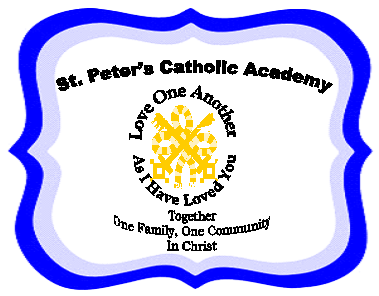Phonics

At St. Peter’s Catholic Academy we follow the phonic bug programe. This is how we progress throughout Early Years and Key Stage One:
Nursery- Phase 1
Reception- Phase 2 and 3
Year 1- Phase 5
Year 2- Phase 5 (short recap), Support for Spelling.
Please check class pages for up to date weekly information about the phonics your child is learning.
This will tell you what sounds they are learning and there will be useful videos and games to support your child.
Throughout school we follow the Phonics Bug reading scheme
Below is some useful information to support you at home
Phoneme– The sound of a letter. For example /k/.
Grapheme– The way we write the phoneme (sound). For example, /k/ can be written as c k ck qu ch.
Digraphs– Two graphemes that make one phoneme (sound).
Trigraphs– Three graphemes that make one phoneme (sound).
Please find below phonics pronunciation videos to support at home. This will tell you how to pronounce each sound.
Phase 2
https://www.youtube.com/watch?v=-ZtjFIvA_fs
Phase 3
https://www.youtube.com/watch?v=DvOuc7cWXxc
Phase 5
https://www.youtube.com/watch?v=8BwWD2ZlvBY
A summary of each phase can be found below:
| Phase 1 | Phase One activities are arranged under the following seven aspects.
Aspect 1: General sound discrimination – environmental sounds Aspect 2: General sound discrimination – instrumental sounds Aspect 3: General sound discrimination – body percussion Aspect 4: Rhythm and rhyme Aspect 5: Alliteration Aspect 6: Voice sounds Aspect 7: Oral blending and segmenting Each aspect is divided into three strands. Tuning into sounds (auditory discrimination) Listening and remembering sounds (auditory memory and sequencing) Talking about sounds (developing vocabulary and language comprehension). Activities within the seven aspects are designed to help children: 1. listen attentively; 2. enlarge their vocabulary; 3. speak confidently to adults and other children; 4. discriminate phonemes; 5. reproduce audibly the phonemes they hear, in order, all through the word; 6. use sound-talk to segment words into phonemes. |
| Phase 2 | The purpose of this phase is to teach at least 19 letters, and move children on from oral blending and segmentation to blending and segmenting with letters. By the end of the phase many children should be able to read some VC (vowel consonant, i.e. it) and CVC (consonant vowel consonant, i.e. dog) words and to spell them either using magnetic letters or by writing the letters on paper or on whiteboards. During the phase they will be introduced to reading two-syllable words and simple captions. They will also learn to read some high-frequency ‘tricky’ words: the, to, go, no.
The sounds children learn are: Set 1: s a t p Set 2: i n m d Set 3: g o c k Set 4: ck e u r Set 5: h b f, ff l, ll ss |
| Phase 3 | The purpose of this phase is to teach another 25 graphemes, most of them comprising two letters (e.g. oa), so the children can represent each of about 42 phonemes by a grapheme (the additional phoneme /zh/ found in the word vision will be taught at Phase Five). Children also continue to practise CVC blending and segmentation in this phase and will apply their knowledge of blending and segmenting to reading and spelling simple two-syllable words and captions. They will learn letter names during this phase, learn to read some more tricky words and also begin to learn to spell some of these words.
The sounds children learn are: Set 6: j v w x* Set 7: y z, zz qu* Digraphs: ch chip, ar farm, sh shop, or for, ththin/then, ur hurt, ng ring, ow cow, ai rain, oi coin, ee feet, ear dear, igh night, air fair, oa boat, uresure, oo boot/look, er corner. |
| Phase 4 | The purpose of this phase is to consolidate children’s knowledge of graphemes in reading and spelling words containing adjacent consonants and polysyllabic words |
| Phase 5 | The purpose of this phase is for children to broaden their knowledge of graphemes and phonemes for use in reading and spelling. They will learn new graphemes and alternative pronunciations for these and graphemes they already know, where relevant. Some of the alternatives will already have been encountered in the high-frequency words that have been taught. Children become quicker at recognising graphemes of more than one letter in words and at blending the phonemes they represent. When spelling words they will learn to choose the appropriate graphemes to represent phonemes and begin to build word-specific knowledge of the spellings of words.
The alternate spellings of sounds children learn are: ay day, oy boy, wh when, a-e make, ou out, ir girl, ph photo, e-e these, ie tie, ue blue, ew new, i-e like, ea eat, aw saw, oe toe, au Paul, o-e home, u-e rule. i fin, find; ow cow, blow; y yes, by, very; o hot, cold; ie tie, field; ch chin, school, chef; c cat, cent; ea eat, bread; ou out, shoulder, could, you; g got, giant; er farmer, her; u but, put (south); a hat, what. |
